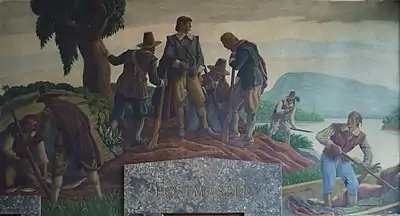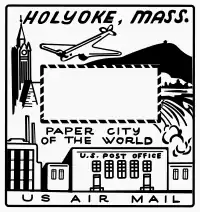United States Post Office–Holyoke Main
The US Post Office—Holyoke Main is a historic post office building at 650 Dwight Street in Holyoke, Massachusetts. It opened in 1935, as a replacement for an earlier post office location at 31 Main Street, and is a distinctive local example of Art Deco architecture. The building was listed on the National Register of Historic Places in 1986.[1]
US Post Office—Holyoke Main | |
 US Post Office-Holyoke Main | |
   | |
| Location | 650 Dwight St., Holyoke, Massachusetts |
|---|---|
| Coordinates | 42°12′29″N 72°36′38″W |
| Area | 1 acre (0.40 ha) |
| Built | 1933 |
| Architect | Alderman, George P.B., & Co.; James, Thomas M., & Co. |
| Architectural style | Art Deco |
| NRHP reference No. | 86000122 [1] |
| Added to NRHP | January 21, 1986 |
The building is one of two post office locations serving the city, with a second in Ingleside at the Holyoke Mall.[2]
Description and history

Holyoke's main post office is located in the city's downtown, on the south side of Dwight Street between Elm and Chestnut Streets. It is a broad two-story structure, built with a steel frame and finished in limestone with granite trim. It has a tall central five-bay section flanked by single-story wings that are two bays wide, with entrances in the outer bays of the central section. Each entry is topped by a transom and a panel with a carved eagle. The main lobby is finished in marble terrazzo flooring, with marble wainscoting and plaster walls, rising to a carved cornice. Part of the wall is painted with a mural depicting the early settlement of Holyoke.[3]
The Art Deco building, a stylistic rarity in Holyoke, was built for a total cost (including land and construction) of $284,000. The lobby mural was executed by Ross Moffett as part of a Depression-era jobs program for artists. The building's location was a matter of some local dispute, with competing interests remaining undecided until the Postal Service threatened to withdraw the project entirely. The second floor interior originally held a variety of other government offices, but is now largely unused.[4]

See also
References
- "National Register Information System". National Register of Historic Places. National Park Service. April 15, 2008.
- Ingleside Mall, USPS Location Details
- "NRHP nomination for United States Post Office–Holyoke Main". National Archive. Retrieved 2018-03-25.
- "MACRIS inventory record for United States Post Office - Holyoke Main". Commonwealth of Massachusetts. Retrieved 2013-12-10.
External links
- USPS Location Details – Holyoke, current operating hours and services offered at the location
